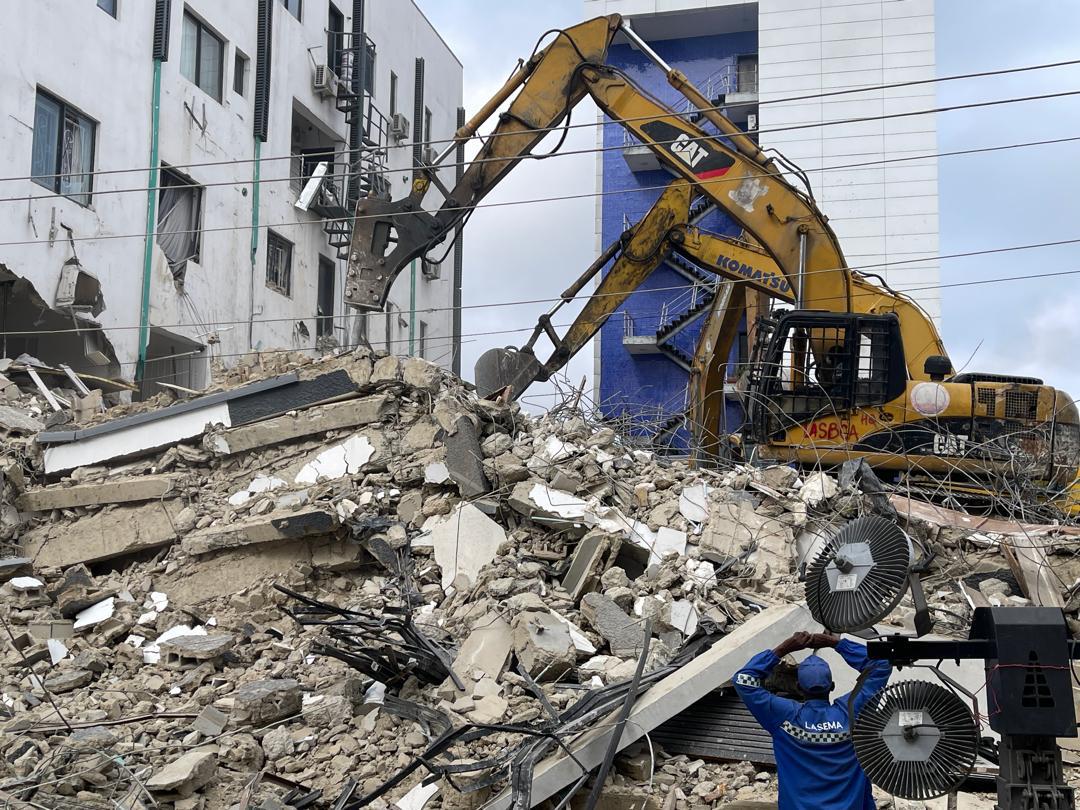Blurting out ‘Eureka’ in the afternoon of Wednesday, October 8, 2025, indicated how excited I became on receiving a call informing me of a discovery. The elusive or forgotten date of what was considered the earliest fatal building collapse in Nigeria had just been retrieved in an archive after several months of search and investigation. What a day! A remarkable day indeed!
Historical information revealed that a four-storey building under construction on Ajibade Street, Oremeji (Coca Cola area) in Ibadan collapsed, leading to the death of over 20 workers. The Western State Fire Service, Nigerian Army, and the police were involved in the rescue operation.
A coroner’s Inquest was set up, and an official investigation to determine the cause(s) of the collapse was conducted. After many years, information about this calamitous collapse became scanty. The exact date of the collapse became unknown. The date and location were confused with other two collapsed buildings in Ibadan. The clarifications are important for research work on building collapse and its prevention.
The compilation of records of collapsed buildings by the Building Collapse Prevention Guild (BCPG) over the years has not been an easy task. It requires continual search for information, verification of the same, and updating of records. The network that has been created across the country, among built environment professionals, has promoted a synergy that enables us to find out information about past collapsed buildings.
Establishing the probable causes of collapsed buildings helps determine preventive measures against recurrence. Recently, in a search for more information about the collapsed hall of the St. Thomas Anglican Church, Arakale Street, Akure, Ondo State, the 81- year old Bldr. Olusola Olowoshile, who is a past chairman of the Nigerian Institute of Building, Ondo State Chapter, volunteered to help retrieve the information from the church. The church building actually collapsed while it was being constructed, and he paid a personal visit to the site almost immediately it collapsed. Then, he studied the causes of the collapse.
A few days later, the chairman was able to contact the contractor, who responded, providing the information that the building collapsed on Wednesday, September 30, 1998. In a verification search to Gani Fawehinmi Library in Ikeja, an old publication of Daily Times confirmed the authenticity of the date. Eight persons, including a three – month-old baby, died while 27 other persons sustained injuries.
Now, here comes the mind – boggling question: Did the four-storey building on Ajibade Street, Oremeji, Ibadan collapse in October 1974 as being speculated on the internet? After some search by the BCPG, it was discovered that the building that collapsed on Thursday, October 30, 1974, was a house with an upper floor (i. e. a 2-storey building). The building, located at Agbeni, Ibadan, collapsed on a mud house, causing the death of a male teenager named Mukaila Orimidara.
The pioneer chairman of the Nigerian Institute of Building, Oyo State Chapter, Samuel Oyeleke Oyedokun, who is also 81 years old, paid a visit to the site of the collapsed four-storey building then. That was before he gained admission into a higher institution of learning to study civil engineering and building.
However, he could no longer recollect the date or year of the collapse. He thought of seeking the information from Azeez Oladejo, an engineer, who designed the building and was exonerated by the Commission of Enquiry since he was not involved in the supervision. Unfortunately, the engineer, we later learnt, died not too long ago. In view of this, the chairman gave me the description of the collapsed building location.
On Saturday, March 15, 2025, I set out early from Lagos, heading to Ibadan. I located the site of the collapsed building on Ajibade Street, Oremeji (Coca Cola area) of Ibadan. I stepped cautiously into Alhaji Ajibade’s compound. I was welcomed by an eerie atmosphere induced by a barking dog. A magnificent mosque now occupies the collapsed building land. On the adjourning land stands the twin structure of the collapsed four-storey building. A woman came out from the four- storey building.
My involvement in investigations of collapsed buildings over the years had prepared me for the unfriendly attitude of this woman when, after exchanging pleasantries, I informed her of my mission. As a tenant, she became scared of my strange mission. It seemed residents in the neighbourhood were oblivious of the collapsed building. Sadly, the landlord, a few years ago, had proceeded to the great beyond. The woman blatantly rejected my request for the contact of any of the landlord’s children. To her, such favour would be tantamount to reminding the family of bad memories.
The implication of succumbing to this sentiment was that researchers on building collapse would be deprived of authentic data. The BCPG records of building collapse in Nigeria have gone global. Hence, one could not afford to give up on this important assignment. Retreat, a defeatist approach should not be an option; in this instance, it was not an option too. Consequently, an idea occurred to me. I pleaded with the woman to direct me to any old inhabitant of the area. She racked her brains and made mention of an Alhaji, pointing to the direction of his house. That settled it!
Some metres away from Alhaji Ajibade’s compound, one could see Ajibade Street abutting the fence of the Oyo State Housing Corporation, Bodija. The proximity of the collapsed Ajibade building to this estate that was formerly known as Western Nigeria Housing Corporation might have confused certain writers after a building in that estate collapsed on Wednesday, May 11, 1977. This building that was described as a two – storey structure collapsed while undergoing construction, killing one person and injuring two workers.
I made enquiries from two persons while directing my driver to the house of the 89- year old retired draughtsman named Ganiyu Oladosu Akanni. He is mostly known in the area as Alhaji. Fortunately, the man was at home. Having introduced myself and my mission, the old man showed enthusiasm in meeting a construction professional of my status. Akanni, whose house was also under construction, was in the vicinity on this particular day and, therefore, witnessed the sad incident at Alhaji Hassan Ajibade’s site. Hence, he narrated what happened. The building, which was of framed structure, had gotten to the third floor. In order to reduce their vertical travelling time while carrying the concrete with headpans, the workers decided to mix the concrete on a suspended slab below the third floor instead of using the natural ground level.
As the casting of the third floor progressed, the structure suddenly failed, collapsing totally on about 30 workers. Alhaji Akanni blamed the collapse on the construction methodology of mixing concrete on a suspended slab that was yet to be supported by walls that could have assisted the columns to bear the excessive loading. He confirmed that concrete cubes were usually taken on the site for the laboratory tests. However, he could not recollect the exact date or year of the incident. He lamented that the draughtsman, his colleague that designed the building, Mr Alimi Sanni was no longer alive to avail us the required information. I proceeded to the University of Ibadan, where I was scheduled to deliver a paper that very day at the workshop of the Nigerian Institution of Civil Engineers titled; ‘Building Right, Building Safe : A Collaborative Approach To Preventing Building Collapse’.
The challenge of getting the accurate date for the Ajibade building collapse was delved into at the forum. Weeks later, the search for the date continued unabated. Retired government officials/civil servants, librarians, and other relevant persons were contacted in respect of the Commission of Enquiry’s white paper to no avail. The Chairman of Oyo State BCPG Chapter, Oye Sobowale, an architect, in an official letter, sought for the assistance of the University of Ibadan library. Based on this, Arc. Bukola Ogundairo and others searched volumes of documents in the library, recording no success.
Peter Soneye and Fatai Olugbade, on behalf of BCPG Oyo State Chapter, decided to pay a visit to the Ajibade family house in order to seek an audience with the family. None of the family members was around.
Somehow, someone deftly managed to secure the phone number of a relation of the landlord. Even if he was not born then, or he was too young when the building collapsed, he should be able to assist in searching for the relevant documents in the house. Definitely, this sensitive exercise must be handled with strategic carefulness.
My optimism was accelerated as I greeted him on the phone, hoping to book an appointment with him. His response was warm. The solution to our challenge seemed to have arrived. Later, I sent a message to his WhatsApp in order to establish a good rapport with him in preparation for our meeting. Surprisingly, he did not take my calls again. “Have I handled the process imperfectly, thereby frittering away a rare opportunity,” I wondered.
The search had definitely arrived at another cul-de-sac! Failure stared me in the face, making a mockery of several efforts. Way forward? Trying hard not to slip into the abyss of frustration, it occurred to me to reach out to an experienced investigative journalist. I narrated our ordeal. He asseverated that he did not know this family. However, he saw the importance of our investigations.
Consequently, he buoyed up my spirit. He emphasised the need to carry out a video recording of the interview with Alhaji Akanni. According to him, such historical experience should be properly documented for safety promotions in the Nigerian construction industry. Life is ephemeral.
He was right. In respect of sourcing information for this building collapse records, death had ruthlessly upended continuity, embossing on our consciousness its inevitability. Most of those who could have availed us of the much needed information are no longer alive.
How many people cultivated the habit, the discipline of recording daily activities in diaries? How many town planning offices in Nigeria can provide in good condition the approved building plans of old buildings? How could publications and recordings of media houses, especially those that are defunct, such as Daily Times, Concord newspapers, be safely stored?
A visit to the Nigerian Tribune library during this search for the report on the collapsed Ajibade building revealed the unavailability of some of the organisation’s old newspaper publications. The national and other libraries, despite downward patronage, need improvement in their archival system. In this digital age, one wonders why important publications and government documents could not be scanned and archived accordingly. The need to preserve history really dawned on us.
Prompted by the journalist’s advice; on Wednesday, October 8, 2025, the Chairman of the NIOB Oyo State Chapter, Bldr. Femi Adeyi paid a second visit to Alhaji Akanni. The video recording of an eye- witness account of the much sought-after collapsed building details commenced in earnest. Bldr. Adeyi endeavoured to help Alhaji Akanni jog his brain in order to figure out the exact year the building collapsed.
Alhaji recalled that the building collapsed while the construction of his own house was in progress. He remembered he commenced the construction of his house in 1969 and it spanned to 1976. He remembered his house was at the first – floor stage when the Ajibade building collapsed. With full concentration, he made a deep mental calculation, trying to determine the duration of the first storey construction. Could Papa recall a major event that happened around the period the building in question collapsed? Coincidentally, while the interview of Alhaji was going on in Ibadan, in far away Lagos, those who had been searching archives for weeks were assiduously busy on the assignment.
A phone call I received from a young graduate of civil engineering, Ope Ogunsanwo and a librarian, Ruth Solomon, subjected me to an excruciating suspense. I sensed something was in the offing. I was all agog.
Then suddenly, the news hit me blissfully. I sighed with relief. Smiling beatifically, I gazed at the WhatsApp messages on my phone. The elusive, evasive, and inaccessible date had just been discovered, retrieved, unravelled, and exhumed gleefully from the archives. Details of the collapse, causes, and pictures were a delight to see. Lots of incontrovertible evidence.
“Eureka!”
The four- storey building under construction on Ajibade Street, Oremeji, Ibadan collapsed at about 2 pm on Wednesday, October 6, 1971, killing 24 persons.
Lives and huge investment painfully lost in a twinkling of an eye. This tragedy happened exactly 54 years ago. The findings, of course, would be submitted to the BCPG Technical Committee on Collapsed Building Records headed by Charles Bola Oresanwo for onward analysis, review, and updating.
Commendations go to numerous people who worked and assisted in the long and tedious process of sourcing for genuine information that will enrich BCPG data on building collapse in Nigeria. Congratulations to building collapse research enthusiasts.
Awobodu is the pioneer National President, Building Collapse Prevention Guild, and former National President, Nigerian Institute of Building.






